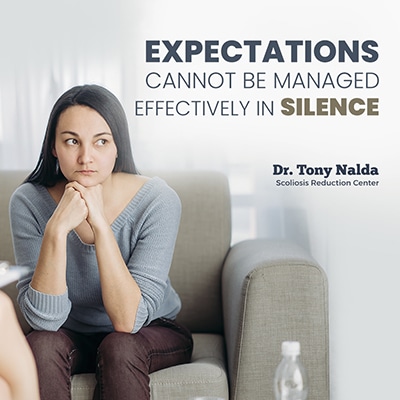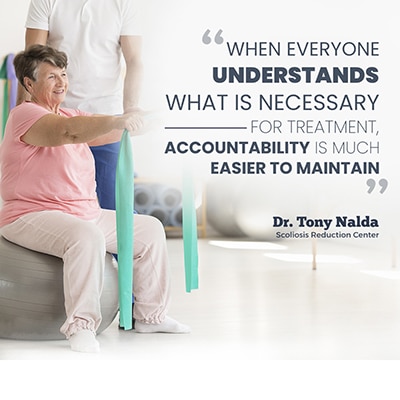
One of the keys to treating any medical condition is managing expectations. Successful outcomes are much more likely when everyone is on the same page. This means not only the patient, but family members, loved ones and members of the treatment team.
Unfortunately, “expectation gaps” emerge more often than not when so many different people become involved in the treatment of a condition.
What do I mean by that?
Let’s say an adolescent patient has received a diagnosis of scoliosis. Typically, a parent will spend many hours researching the condition and developing expectations about the possibility of recovery. They will read about the traditional, surgically focused approach to treatment, but they will also spend some time looking at alternative treatments, some of which may be valid, while others are not.
Through this research, they will develop expectations. They may be overly skeptical and assume that surgery is inevitable, and that alternative treatment methods are not worth pursuing. Or they may be overly optimistic and expect that their child will miraculously recover and resume normal activity within a very brief time frame. Because there is so much information to wade through, particularly online, the range of possible expectations is very wide!
Meanwhile, the adolescent patient is hearing anecdotal accounts from their peers about older siblings with the condition, or they are talking to classmates who live with scoliosis. They may even perform their own research into the condition. Along the way, they will develop expectations of their own. However, where the parent is likely looking at the condition from a longer-term perspective, the adolescent patient may be more focused on how the condition will impact their social standing in the here and now. Or they will focus on their ability to participate in activities they love.
At the same time, medical professionals are developing their own expectations based on viewing X-rays, analyzing the patient’s medical history and creating their own assessments. Under the traditional treatment model, a number of specialists may become involved in the care of the patient, which only multiplies the number of different expectations that are involved.
Additionally, friends, family members and others bring their own expectations to the table — and almost no one is on the same page!
This is just one possible example; expectation gaps emerge all the time when dealing with scoliosis. But I don’t think it has to be this way.

Expectations cannot be managed effectively in silence. Communication is the key to ensuring success, regardless of the treatment path that’s taken.
In my practice, I regard the setting and managing of expectations as a serious responsibility. After all, scoliosis is my specialty, so it is my duty to ensure that patients, parents and loved ones understand the condition.
Here are some of the factors I discuss with patients and parents to ensure that we are all on the same page:

Of course, I cannot speak for doctors and other medical professionals who represent the traditional model of treatment; I can only speak for myself and the treatment approach that I believe in. But if a patient becomes interested in the chiropractic-centered, functional approach to treatment, I want them to know what can be reasonably expected.
Obviously, every patient is different, but generally speaking, this is what I want patients, parents and others to understand about my approach:
Knowing what to expect after a scoliosis diagnosis is important. It’s even more important to ensure that you are on the same page with your doctor and other professionals who may be involved in treatment.
Because the Scoliosis Reduction Center provides a comprehensive treatment approach, it’s easier for me to ensure that my patients and I are always aligned when it comes to expectations. We provide chiropractic care, of course, but we also guide patients through a process that includes physical therapy, custom bracing and scoliosis-specific exercises. Our patients find it easy to manage expectations because they aren’t traveling from specialist to specialist. They are also kept in the loop about the realities of their treatment — lines of communication are always kept open!
If you’re interested in learning more about scoliosis expectations or the nature of chiropractic-centered treatment, I encourage you to give our office a call today at 321-939-2328.
